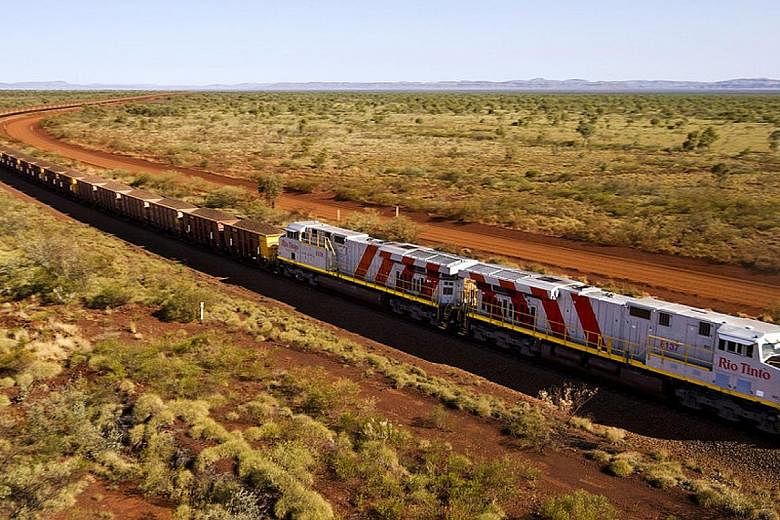SYDNEY • In north-west Australia, a series of trains installed with new "driverless" technology has been deployed to deliver iron ore from 16 remote mines to coastal ports, in what has been labelled "the world's biggest robot".
The 2.4km-long trains, officially launched earlier this year by mining giant Rio Tinto, travel across 1,700km of tracks. The round-trip journeys can reportedly take up to 46 hours, but there is no need to swop tired drivers along the way. The trains are operated from a control room in Perth 1,500km away.
Labelled a world first, the A$940 million (S$889 million) project reflects a significant shift in the mining sector as companies increasingly look to automated processes and robotics.
New technologies such as driverless trucks and trains and robotic drills can improve safety and efficiency for mining firms, but they can also lead to heavy losses of jobs in a sector that has traditionally required significant workforces.
For Australia, which has been enjoying soaring commodities trade, these changes may mean that the industry no longer delivers the sudden bursts of jobs that typically accompany mining booms.
In Western Australia, the centre of the nation's mining sector, there are about 106,000 people employed in the industry. Employment there has increased in recent years and is almost at the level during the peak of the mining investment boom in 2013, when 116,000 people were working in the sector.
Professor Allan Trench from the University of Western Australia, an expert on mineral economics, said automation was having a significant effect.
Firms can now operate their processes in the Pilbara region from control centres in Perth, which "are like the helm of the Starship Enterprise", he told The Straits Times, referring to science-fiction series Star Trek. "Inevitably there is a reduction in people. I don't think you can get away from that. It is the more manual tasks that disappear."
He said the biggest changes were occurring in mines involving large-scale operations, such as those extracting iron and copper ore. Operations such as gold mines were harder to automate, he added.
-
106,000
-
Number of people employed in the mining industry in Western Australia, the centre of Australia's mining sector.
The mining sector's strength has encouraged firms to invest in new projects. But there are growing questions about how many jobs these - and such mining surges in the future - might produce.
A report from consulting firm McKinsey & Company earlier this year found that automation will take a heavy toll on remote mining areas such as the Pilbara. It said that by 2030, automation will have a "considerable impact on local communities" in parts of the region where mining can account for almost 60 per cent of jobs.
"Across regions, the impact could vary from 21 per cent in city centres dominated by professional services to over 30 per cent in mining regions like the Pilbara," it said.
Despite Australia's decade-long mining boom ending more than five years ago, trade in commodities has continued to surge. Last year, Australia exported A$217 billion worth of minerals and fuels, up from A$142 billion in 2016 and A$160 billion at the peak of the boom in 2011.
The recent increase has been due to high coal and iron ore prices, as well as continued strong demand from China. In June, Australia supplied a record 74 per cent of China's imported iron ore.
Mr Jim Walker, chair of Western Australia's State Training Board, said automated mines will still need workers, but that their skill requirements will be different from those of traditional operations.
"It does replace jobs," he told ABC News. "But what's actually happening in the mining operations right now, they still need people to service the equipment, they still need people to work in the control rooms, they still need people to get the equipment running every day."
Prof Trench said he believed that larger mining companies were increasingly looking to adopt automated processes, but that smaller firms remained dependent on traditional workforces. "At the moment, if you lose a job as a truck driver in a big company, you can still get a job at a smaller company."
Jonathan Pearlman


